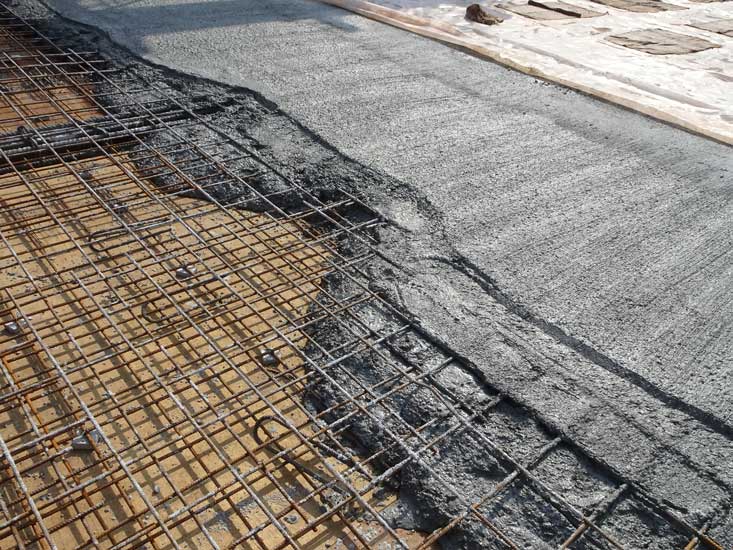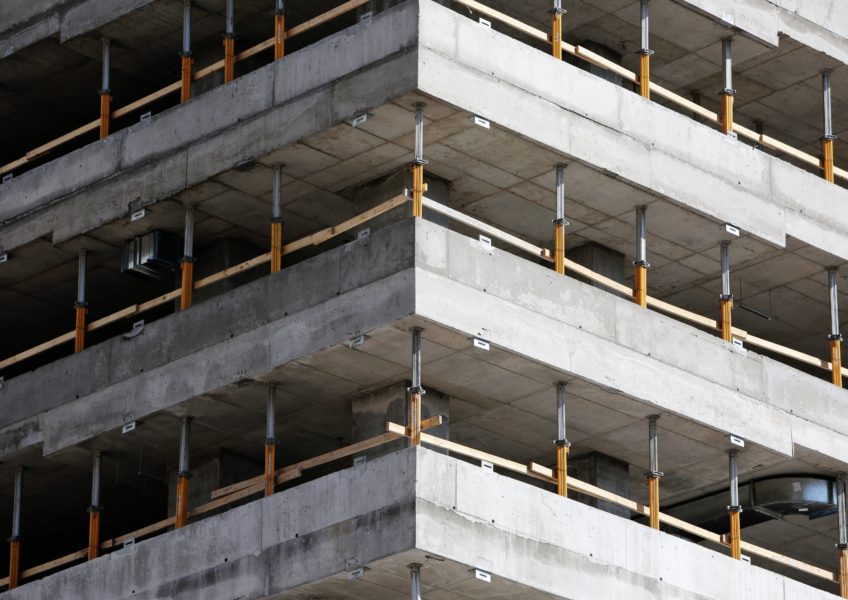The Crucial Role of Concrete Foundation in Structural Stability and Long Life
When it comes to building a building, the foundation is extra critical than you might think. Concrete foundations provide unrivaled strength and sturdiness, guaranteeing your structure can endure different environmental challenges. Without a solid base, you risk possible issues like shifting or cracking, which can compromise safety and worth. Recognizing the nuances of concrete structures might be the trick to maintaining your investment for many years ahead. What should you take into consideration following?
Recognizing the Relevance of Concrete Foundations
Concrete structures are important to the overall security of any kind of framework, as they provide the vital support required to endure various lots and environmental problems. When you consider building a home or a commercial area, the foundation is the first point you ought to take into consideration. It works as an obstacle against dampness, securing your residential property from water damages. A well-placed concrete foundation additionally protects against settling and moving, which can cause fractures in walls and floors. You'll intend to assure that the structure is effectively developed and reinforced, as this influences the long life of your structure. Furthermore, a solid structure can improve energy efficiency by decreasing air leakages. Keep in mind, neglecting the relevance of a concrete foundation can bring about costly repairs down the line. So, spending in a top quality structure upfront is vital for the stability and longevity of your structure.
Benefits of Concrete Structures for Structural Integrity
While numerous factors add to a building's architectural integrity, concrete foundations supply unmatched sturdiness and strength. You'll appreciate that concrete can withstand extreme weather problems, withstanding both moisture and temperature level fluctuations. This durability suggests your structure is less most likely to experience fracturing or shifting over time, which can jeopardize its safety.Additionally, concrete's inherent weight gives a solid base, stopping activity during all-natural events like quakes or floodings. When you pick a concrete foundation, you're also opting for low upkeep; unlike timber, it will not rot or attract bugs, conserving you time and cash in repairs.Moreover, concrete's fire resistance offers included safety, guaranteeing your framework can withstand heats without significant damages. On the whole, buying a concrete foundation implies you're focusing on the lasting stability and stability of your building, making it a sensible option for any kind of building and construction project.
Usual Types of Concrete Foundations
When it comes to building structures, comprehending the typical kinds of concrete structures can assist you make informed selections for your job. The most widespread types include slab-on-grade, crawl room, and full basement foundations.A slab-on-grade structure is a basic, cost-efficient choice, where a thick concrete slab is put directly on the ground. This kind works well in warm environments, as it decreases warm loss.Crawl space structures elevate the home a little above ground, permitting ventilation and accessibility to plumbing and electric systems. This design can aid avoid moisture issues.Full cellar foundations use additional living or storage room while providing superb structural assistance. They require even more excavation and are usually used in chillier environments to stop frost heave.
Factors to Take Into Consideration When Designing a Concrete Structure

Finest Practices for Putting Up Concrete Foundations
When you're installing a concrete structure, proper site prep work is important to assure stability (West Coast General Engineering concrete foundation Rancho Cucamonga). You'll also need to comprehend support methods to boost stamina and sturdiness. Ultimately, don't overlook the curing procedure, as it plays a fundamental role in attaining a strong structure
Website Prep Work Significance
Although it might appear simple, proper website prep work is important for guaranteeing a solid and sturdy concrete structure. Beginning by removing the area of any kind of particles, greenery, or natural product that could endanger the structure's integrity. Next off, analyze the dirt type and compaction; you might require to excavate or include products to produce a stable base. Degree the ground to ensure also weight distribution and avoid working out concerns in the future. Installing correct drain systems is additionally important to stop water accumulation, which can damage the foundation over time. Lastly, mark out the foundation's measurements precisely to lead the pouring procedure. By following these actions, you'll set the phase for a successful concrete structure that stands the test of time.
Support Techniques Explained
When the site is appropriately prepared, the next action in guaranteeing a tough concrete foundation includes applying effective reinforcement methods. You should start by making use of steel rebar, which provides tensile stamina and aids avoid splitting. Lay the rebar in a grid pattern, making certain it rises utilizing spacers to keep proper protection. In addition, consider utilizing cord mesh for added assistance, specifically in areas subject to hefty loads. Do not forget to connect the rebar junctions safely with cable. For bigger foundations, fiber reinforcement can improve longevity, minimizing the risk of contraction splits. Constantly follow neighborhood building codes and standards to ensure compliance. By applying these reinforcement techniques, you'll considerably enhance your structure's stamina and durability, laying a strong groundwork for your framework.
Treating Process Fundamentals
To guarantee your concrete foundation treatments appropriately, it's essential to maintain ample dampness and temperature conditions quickly after putting. Beginning by covering the surface with a damp burlap or plastic bed linen to maintain moisture. This keeps the concrete hydrated, protecting against splits and making certain toughness. You should likewise keep an eye on the temperature level; ideal curing problems are in between 50 ° F and 90 ° F. If it's also warm, mist the surface regularly to stop quick evaporation. For winter, consider utilizing insulating blankets to preserve heat. Objective for a curing duration of at the very least seven days, as this is crucial for optimum stamina growth. By complying with these ideal methods, you'll boost your structure's longevity and durability, making certain architectural integrity for several years to come.
Upkeep of Concrete Structures for Longevity
To keep your concrete foundation strong and enduring, regular examinations are necessary. You should also guarantee reliable drainage solutions remain in location to avoid water damage. If you detect any kind of fractures, resolving them without delay will save you from bigger problems down the line.

Normal Inspections and Analyses
While regular evaluations and assessments might feel like a task, they're important for preserving the stability of your concrete foundation. By consistently looking for fractures, shifts, or signs of wear, you can capture prospective concerns prior to they intensify right into pricey fixings. Search for any water merging around the foundation or unusual settling, as these can signify underlying troubles. It's additionally a good idea to keep an eye on any type of modifications in your home's framework, like doors that stick or home windows that don't open smoothly. Keeping a document of your examinations assists track modifications gradually, enabling for proactive upkeep. Ultimately, these assessments assure your foundation continues to be steady, supporting the long life and safety of your entire structure. Do not neglect this essential facet of homeownership!
Reliable Drain Solutions
Normal examinations can disclose issues like water drainage issues that might jeopardize your concrete foundation's stability. To stop water buildup, guarantee your seamless gutters and downspouts straight water away from the foundation. Installing French drains can properly redirect surface area and groundwater, reducing pressure on your foundation walls. In addition, grading the dirt around your home assists assure that water streams away, instead than merging near your foundation.Consider making use of sump pumps in areas susceptible to flooding, as they proactively remove excess water. Consistently look web link for obstructions in drain systems and clear them immediately. You'll secure your foundation's integrity and durability by taking these positive steps. Remember, efficient water drainage services are essential for preserving a solid, resilient concrete structure.
Trigger Fracture Fixes
When you discover fractures in your concrete structure, resolving them without delay is crucial for preserving its longevity. Little splits can promptly progress right into bigger issues, jeopardizing the architectural integrity of your home. Regularly inspect your foundation for indicators of damages, such as straight or upright cracks. If you spot any type of, don't wait-- fix them quickly. You can utilize epoxy injections or concrete patching substances, which are efficient for securing cracks. Constantly follow the maker's directions and consider getting in touch with an expert for significant damage. Remember, timely fixings not only boost your foundation's sturdiness but likewise conserve you cash in the cement moulding design future by stopping extra comprehensive repair work down the line. Remain aggressive, and your foundation will remain strong and safe.
Resolving Common Issues With Concrete Structures
Concrete structures can encounter various issues with time, making it crucial to recognize and resolve them quickly. Among the most common troubles is breaking, which can take place because of temperature level fluctuations or resolving soil. If you see cracks, it's important to evaluate their dimension and depth; little splits can typically be secured, while larger ones may call for professional evaluation.Water invasion is another major problem. Excess moisture can cause mold and mildew growth and architectural wear and tear. Assurance correct drainage around your structure to reduce this danger. Additionally, seek indications of changing or bowing walls, as this can show underlying issues with your foundation's stability.Regular examinations are fundamental to catch these troubles early. If you detect any type of worrying signs, don't hesitate to get in touch with a foundation professional. By remaining proactive, you can preserve the stability and longevity of your concrete foundation, ensuring your home continues to be safe and safe.
Frequently Asked Concerns
Just How Does Dirt Type Impact Concrete Structure Performance?
Soil kind greatly impacts concrete structure efficiency. If you have actually got extensive clay, for instance, it can browse around these guys cause changing and cracking. Sandy soil might lead to settling. Understanding your dirt aids assure a steady foundation.
Can Concrete Foundations Be Fixed if Harmed?
Yes, you can fix damaged concrete foundations. Depending on the level of the damages, methods like epoxy injection or slab jacking can recover security. It's finest to seek advice from an expert for effective solutions.
What Is the Regular Life-span of a Concrete Structure?
A concrete foundation typically lasts 30 to 100 years, relying on variables like dirt conditions, environment, and upkeep. You'll intend to watch on it to guarantee it continues to be in great shape throughout its life-span.
Exist Option Materials to Concrete for Foundations?
Yes, there are choices to concrete for structures, like steel, timber, and even recycled products. Each option has one-of-a-kind benefits and drawbacks, so you ought to consider your project's particular needs when picking the right material.
Just How Does Environment Effect Concrete Structure Longevity?
Environment considerably affects concrete structure resilience (West Coast General Engineering concrete foundation Rancho Cucamonga). Extreme temperature levels, dampness, and freeze-thaw cycles can deteriorate the product, bring about fractures and architectural concerns. You should consider local climate problems when intending your structure to assure lasting efficiency
Comments on “How to Improve Your Project’s Lifespan with West Coast General Engineering industrial concrete”